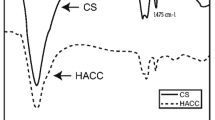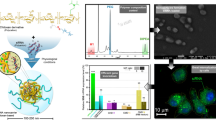ABSTRACT
Purpose
To design hyaluronic acid (HA) and chitosan-g-poly(ethylene glycol) (CS-g-PEG) nanoparticles intended for a broad range of gene delivery applications.
Methods
Nanoparticles formulated at different HA/CS-g-PEG mass ratios were developed to associate either pDNA or siRNA. The physico-chemical characteristics, morphology, association efficiency and nuclease protection ability of the nanocarriers were compared for these two molecules. Their biological performance, including transfection effciency, nanoparticle cellular uptake and citotoxicity, was assesed.
Results
The resulting nanoparticles showed an adequate size (between 130 and 180 nm), and their surface charge could be modulated according to the nanoparticle composition (from +30 mV to −20 mV). All prototypes exhibited a greater association efficiency and nuclease protection for pDNA than for siRNA. However, cell culture experiments evidenced that HA/CS-g-PEG nanoparticles were effective carriers for the delivery of both, siRNA and pDNA, eliciting a biological response with minimal cytotoxicity. Moreover, experiments performed in the HEK-EGFP-Snail1 cell line showed the potential of the HA/CS-g-PEG nanoparticles to silence the expression of the Snail1 transcription factor, an important mediator in tumor progression.
Conclusions
HA/CS-g-PEG nanoparticles can be easily modulated for the delivery of different types of gene molecules, offering great potential for gene therapy applications, as evidenced by their biological performance.










Similar content being viewed by others
REFERENCES
Elbashir SM, Harborth J, Lendeckel W, Yalcin A, Weber K, Tuschl T. Duplexes of 21-nucleotide RNAs mediate RNA interference in cultured mammalian cells. Nature. 2001;411:494–8.
Castanotto D, Rossi JJ. The promises and pitfalls of RNA-interference-based therapeutics. Nature. 2009;457:426–33.
MacLaughlin FC, Mumper RJ, Wang J, Tagliaferri JM, Gill I, Hinchcliffe M, et al. Chitosan and depolymerized chitosan oligomers as condensing carriers for in vivo plasmid delivery. J Control Release. 1998;56:259–72.
Gao S, Chen J, Dong L, Ding Z, Yang Y-h, Zhang J. Targeting delivery of oligonucleotide and plasmid DNA to hepatocyte via galactosylated chitosan vector. Eur J Pharm Biopharm. 2005;60:327–34.
Howard KA, Rahbek UL, Liu X, Damgaard CK, Glud SZ, Andersen MO, et al. RNA Interference in vitro and in vivo using a novel chitosan/siRNA nanoparticle system. Mol Ther. 2006;14:476–84.
Katas H, Alpar HO. Development and characterisation of chitosan nanoparticles for siRNA delivery. J Control Release. 2006;115:216–25.
de la Fuente M, Seijo B, Alonso MJ. Novel hyaluronan-based nanocarriers for transmucosal delivery of macromolecules. Macromol Biosci. 2008;8:441–50.
de la Fuente M, Seijo B, Alonso MJ. Bioadhesive hyaluronan-chitosan nanoparticles can transport genes across the ocular mucosa and transfect ocular tissue. Gene Ther. 2008;15:668–76.
de la Fuente M, Seijo B, Alonso MJ. Novel hyaluronic acid-chitosan nanoparticles for ocular gene therapy. Invest Ophthalmol Vis Sci. 2008;49:2016–24.
Csaba N, Koping-Hoggard M, Fernandez-Megia E, Novoa-Carballal R, Riguera R, Alonso MJ. Ionically crosslinked chitosan nanoparticles as gene delivery systems: effect of PEGylation degree on in vitro and in vivo gene transfer. J Biomed Nanotech. 2009;5:162–71.
Urban-Klein B, Werth S, Abuharbeid S, Czubayko F, Aigner A. RNAi-mediated gene-targeting through systemic application of polyethylenimine (PEI)-complexed siRNA in vivo. Gene Ther. 2005;12:461–6.
Minakuchi Y, Takeshita F, Kosaka N, Sasaki H, Yamamoto Y, Kouno M, et al. Atelocollagen-mediated synthetic small interfering RNA delivery for effective gene silencing in vitro and in vivo. Nucleic Acids Res 32: (2004).
Peinado H, Marin F, Cubillo E, Stark HJ, Fusenig N, Nieto MA, et al. Snail and E47 repressors of E-cadherin induce distinct invasive and angiogenic properties in vivo. J Cell Sci. 2004;117:2827–39.
Cano A, Perez-Moreno MA, Rodrigo I, Locascio A, Blanco MJ, Del Barrio MG, et al. The transcription factor Snail controls epithelial-mesenchymal transitions by repressing E-cadherin expression. Nat Cell Biol. 2000;2:76–83.
Lamarque G, Lucas JM, Viton C, Domard A. Physicochemical behavior of homogeneous series of acetylated chitosans in aqueous solution: role of various structural parameters. Biomacromolecules. 2005;6:131–42.
Aktas Y, Yemisci M, Andrieux K, Gursoy RN, Alonso MJ, Fernandez-Megia E, et al. Development and brain delivery of chitosan-PEG nanoparticles functionalized with the monoclonal antibody OX26. Bioconj Chem. 2005;16:1503–11.
Prego C, Torres D, Fernandez-Megia E, Novoa-Carballal R, Quiñoa E, Alonso MJ. Chitosan-PEG nanocapsules as new carriers for oral peptide delivery: effect of chitosan pegylation degree. J Control Release. 2006;111:299–308.
Calvo P, Remuñan-Lopez C, Vila-Jato JL, Alonso MJ. Novel hydrophilic chitosan-polyethylene oxide nanoparticles as protein carriers. J Appl Polym Sci. 1997;63:125–32.
Peinado H, Ballestar E, Esteller M, Cano A. Snail mediates E-cadherin repression by the recruitment of the Sin3A/Histone deacetylase 1 (HDAC1)/HDAC2 complex. Mol Cell Biol. 2004;24:306–19.
Moreno-Bueno G, Peinado H, Molina P, Olmeda D, Cubillo E, Santos V, et al. The morphological and molecular features of the epithelial-to-mesenchymal transition. Nat Protoc. 2009;4:1591–613.
de la Fuente M, Seijo B, Alonso MJ. Design of novel polysaccharidic nanostructures for gene delivery. Nanotech. 2008;19:075105.
Bloomfield VA. DNA condensation. Curr Opin Struc Biol. 1996;6:334–41.
Bloomfield VA. DNA condensation by multivalent cations. Biopolymers. 1997;44:269–82.
Malek A, Czubayko F, Aigner A. PEG grafting of polyethylenimine (PEI) exerts different effects on DNA transfection and siRNA-induced gene targeting efficacy. J Drug Target. 2008;16:124–39.
Kabanov AV, Kabanov VA. DNA complexes with polycations for the delivery of genetic material into cells. Bioconj Chem. 1995;6:7–20.
Gary DJ, Puri N, Won YY. Polymer-based siRNA delivery: perspectives on the fundamental and phenomenological distinctions from polymer-based DNA delivery. J Control Release. 2007;121:64–73.
Bartlett DW, Davis ME. Physicochemical and biological characterization of targeted, nucleic acid-containing nanoparticles. Bioconj Chem. 2007;18:456–68.
Banan M, Puri N. The ins and outs of RNAi in mammalian cells. Curr Pharm Biotech. 2004;5:441–50.
Kabanov AV, Astafyeva IV, Chikindas ML, Rosenblat GF, Kiselev VI, Severin ES, et al. DNA interpolyelectrolyte complexes as a tool for efficient cell transformation. Biopolymers. 1991;31:1437–43.
Csaba N, Koping-Hoggard M, Alonso MJ. Ionically crosslinked chitosan/tripolyphosphate nanoparticles for oligonucleotide and plasmid DNA delivery. Int J Pharm. 2009;382:205–14.
Laurent TC, Fraser JRE. Hyaluronan. FASEB J. 1992;6:2397–404.
Rojanarata T, Opanasopit P, Techaarpornkul S, Ngawhirunpat T, Ruktanonchai U. Chitosan-thiamine pyrophosphate as a novel carrier for siRNA delivery. Pharm Res. 2008;25:2807–14.
Plattt VM, Szoka Jr FC. Anticancer therapeutics: targeting macromolecules and nanocarriers to hyaluronan or CD44, a hyaluronan receptor. Mol Pharm. 2008;5:474–86.
Stetler-Stevenson WG, Aznavoorian S, Liotta LA. Tumor cell interactions with the extracellular matrix during invasion and metastasis. Annu Rev Cell Biol. 1993;9:541–73.
Thiery JP. Epithelial–mesenchymal transitions in tumour progression. Nat Rev Cancer. 2002;2:442–54.
Birchmeier W, Behrens J. Cadherin expression in carcinomas: role in the formation of cell junctions and the prevention of invasiveness. Biochim Biophys Acta. 1994;1198:11–26.
Barrallo-Gimeno A, Nieto MA. The Snail genes as inducers of cell movement and survival: implications in development and cancer. Development. 2005;132:3151–61.
Peinado H, Olmeda D, Cano A. Snail, ZEB and bHLH factors in tumour progression: an alliance against the epithelial phenotype? Nat Rev Cancer. 2007;7:415–28.
Espineda CE, Chang JH, Twiss J, Rajasekaran SA, Rajasekaran AK. Repression of Na, K-ATPase β1-subunit by the transcription factor Snail in carcinoma. Mol Biol Cell. 2004;15:1364–73.
Olmeda D, Jorda M, Peinado H, Fabra A, Cano A. Snail silencing effectively suppresses tumour growth and invasiveness. Oncogene. 2007;26:1862–74.
Olmeda D, Moreno-Bueno G, Flores JM, Fabra A, Portillo F, Cano A. SNAI1 is required for tumor growth and lymph node metastasis of human breast carcinoma MDA-MB-231 cells. Cancer Res. 2007;67:11721–31.
ACKNOWLEDGEMENTS
The authors gratefully acknowledge valuable discussion with Dr. M. de la Fuente and support from the Ministry of Science and Technology (Spain) (Refs. SAF2004-09230-004-01 and SAF2004-C04-02). The first author also acknowledges the fellowship received from the Spanish Government (FPI).
Author information
Authors and Affiliations
Corresponding author
Elecrtonic Supplementary Material
Below is the link to the electronic supplementary material.
Supplementary Figure 1
Expression of EGFP and Snail-EGFP protein in HEK-EGFP and HEK-EGFP-Snail1 cell line by western blotting. WB on whole cell lysates from HEK-EGFP (left) and HEK-EGFP-Snail1 (right) cells was performed as previously described (20) using anti-Snail (upper panel) or anti-EGFP (middle panels). Anti-tubulin antibodies were used as a loading control. (DOC 56 kb)
Supplementary Figure 2
Comparison of EGFP expression in non treated HEK-EGFP cells or after si-Snail1 loaded HA/CS-g-PEG 1/1 nanoparticles treatment (100 nM siRNA/well). (DOC 38 kb)
Rights and permissions
About this article
Cite this article
Raviña, M., Cubillo, E., Olmeda, D. et al. Hyaluronic Acid/Chitosan-g-Poly(ethylene glycol) Nanoparticles for Gene Therapy: An Application for pDNA and siRNA Delivery. Pharm Res 27, 2544–2555 (2010). https://doi.org/10.1007/s11095-010-0263-y
Received:
Accepted:
Published:
Issue Date:
DOI: https://doi.org/10.1007/s11095-010-0263-y




